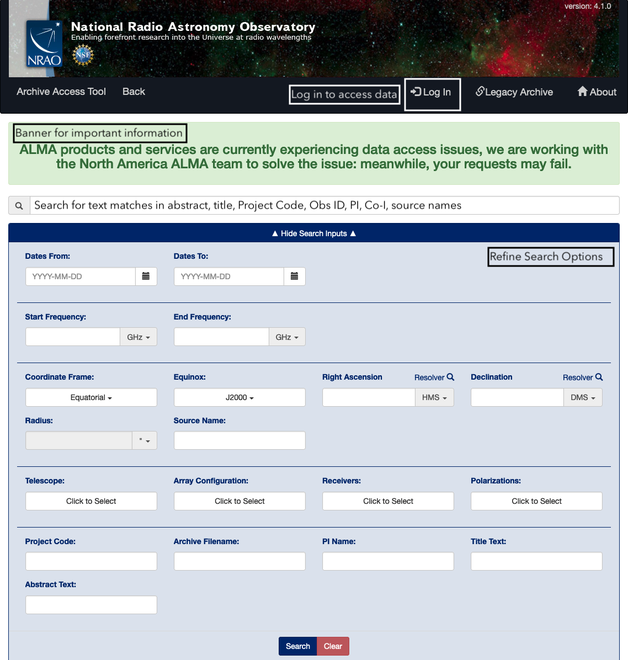NRAO Data Archive
The NRAO archive can be accessed at https://data.nrao.edu
Locating and unlocking data
Newly observed VLA data are transferred to the NRAO archive and available for retrieval to those with the appropriate privileges approximately 10 minutes after the end of the observations. The archive content can be accessed through the Archive Access Tool (AAT). The online archive contains all VLA data since observing started in 1976.
The AAT search provides a data retrieval tool which can be used either as a simple search using keywords in the main search box, or an advanced search under the "Show Search Inputs" below the search box. The Search Input option enables searches based on a large number of user-specified criteria. Both proprietary and public data can be downloaded via secure https file transfer. On request, NRAO will ship data on physical hard disks, subject to the conditions of our Data Shipment Policy.
With the exception of some rapid response and large proposals, VLA data associated with a given proposal are normally restricted to proprietary use by the proposing team for a period of 12 months from the date of the last observation in a proposal (Note: data taken more than 12 months previously may still be proprietary, if additional data for the same proposal have been taken within the last 12 months). Any member of the observing team can unlock proprietary data by signing in on the archive page with their my.nrao.edu user ID and password (Figure 1), and using the link "your_username's Data" in the upper right corner of the site.
You need to be PI or co-I on the proposal to be able to access proprietary data. If you were not listed on the original proposal, you must first obtain permission from the PI, who in turn, must contact us through the NRAO Helpdesk to allow your access to those data.
Please, refer to the NRAO Data Archive Policy for more information regarding proprietary data.
 |
| Figure 1. Archive Access Tool Search Parameters |
Data Formats and Data Retrieval
SDM Format
VLA data taken after January 2010, when the transition to the WIDAR correlator took place, are stored in the Science Data Model (SDM) format that is used by both the VLA and ALMA. VLA data are available through the AAT in the following formats:
- In the native Science Data Model (SDM) format.
- As a CASA Measurement Set (MS) created from the SDM, which may be averaged in frequency and/or time, to be used with CASA.
- As a CASA Calibrated Measurement Set (for data observed since the start of A-configuration in 2016).
When requesting the MS format, which consists of a directory with sub-directories, we recommend requesting tar-format. This will collect the whole directory structure in a single file for easy retrieval.
Please note, current known limitations/features of the AAT include:
- All visitor computing account holders can no longer request data directly to be deposited in their accounts. ***By the end of May 2022, this capability is expected to be restored.
- Requests for SDM-BDF and MS of the same observations have to be submitted separately.
- Only a single calibrated MS can be requested at any one time.
- If you request very large tar files (which is the default), the system may time out due to the length of time tar takes to run the tar command. At this point, we do not recommend requesting tar files. Instead download via wget (see below).
- Download requests without tarring will be a directory structure. To download that directory structure use the following wget command, replacing 'https://dl-dsoc.nrao.edu/anonymous/.....' with the link provided in the notification e-mail.
wget -r --reject "index.html*" -np -nH --cut-dirs=3 https://dl-dsoc.nrao.edu/anonymous/.....
- Download requests are returned in a nested directory, with a sub-directory named exactly the same as what you asked for; you will have to go into that sub-directory to get to the requested file, e.g. 20B-099.sb39274643.eb39345634.59269.54178597222.ms/20B-099.sb39274643.eb39345634.59269.54178597222.ms/
Some archival data have known problems which, together with the possible fix, are listed at the archive issues page.
UVFITS Format
Delivery of VLA data in the UVFITS format has been discontinued in June 2013. Instructions to create UVFITS from the SDM or CASA MS format are given below.
For use in CASA
We no longer support the conversion from CASA measurement sets into uv FITS format from within the archive tool.
For use in AIPS
Observers who have installed Obit can convert SDM data directly into UVFITS or load SDM data directly into AIPS. Note that Obit cannot convert complex correlator modes into a single UVFITS/AIPS file, but plain continuum or simple line data is not a problem. The latest version of Obit can be found by scrolling to the bottom of the Obit distribution page. Be aware that Obit is a bit harder to install on Macs than on Linux architectures. To convert SDM data into UVFITS with Obit use these steps:
- download the SDM format from the archive
- using Obit run the task "ASDMList" to obtain a correlator configuration listing for selection
- using Obit run the task "BDFIn" to specify the output UVFITS file name
Alternatively, the SDM can be converted to UVFITS directly with AIPS:
- download the SDM format from the archive
- using AIPS run the task "BDFLIST" to obtain a correlator configuration listing for selection
- using AIPS run the task "BDF2AIPS" to specify the output AIPS file name and disk number
- to write UVFITS file on disk use task "FITAB" or "FITTP"
NVAS Survey
Images, and in many cases, calibrated uv data of the NVAS survey can be obtained from https://www.vla.nrao.edu/astro/nvas/ Searches used to be available through the legacy archive tool, but are currently limited to the more simple interface on the NVAS survey website. We plan to make these data available from the new archive in the future.


